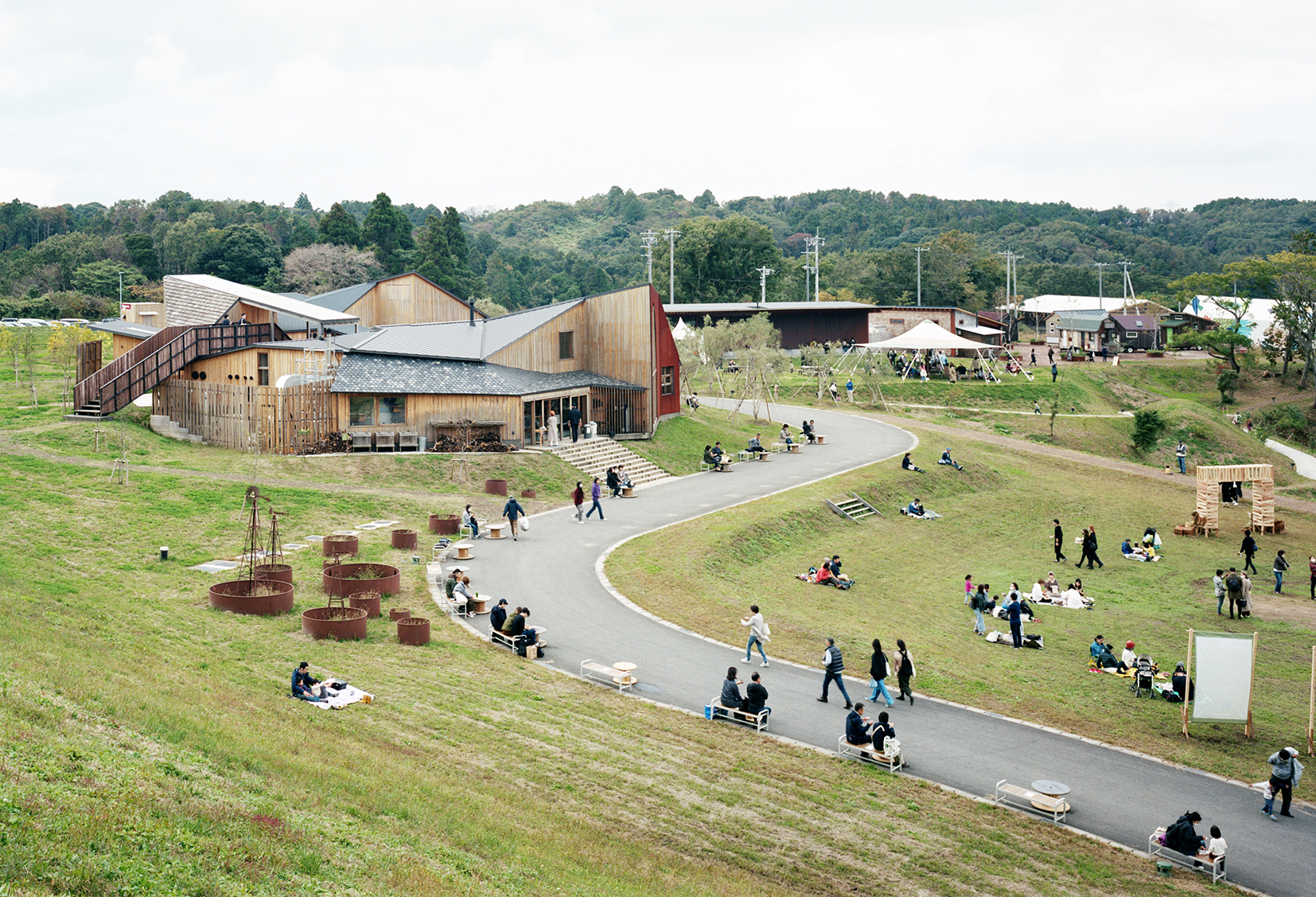KURKKU FIELDS
クルックフィールズ
- SOCIAL LANDSCAPES

クルックフィールズは千葉県・木更津市の30haの農場を舞台に、新しい農の可能性を探求しているプロジェクトで、音楽家の小林武史氏が総合プロデュースを務めている。
私たちは、第1期に向けた全体マスタープラン、地域計画立案サポート、開発設計、ランドスケープデザインの協働、第1期の複数の建築物の設計を行っている。
新しい農業のかたちをつくる
クルックフィールズは新しい有機農業・酪農の在り方を模索する場である。さまざまな模索を可能とするための産業のプラットフォームを、棚田状のランドスケープと共につくっていった。首都圏への安定した有機野菜の供給を支える「農業工場」としての側面。さまざまな有機野菜の生育を実験する「食べられる庭」としての側面。日々生まれてくるアイデアを自分たちの手でつくっていく「ブリコラージュの工房」という側面。多様な価値観が接ぎ木された、多言語的な環境・かたちの統合を目指した。
農業の6次化とはいかに可能なのか、小林武史氏のビジョンや最先端の情報の共有、考えの変遷に併走しながら、実践者の現場をいくつも訪ねていき、リサーチとマスタープランのフィードバックを循環させていった。小林氏、クルックフィールズのスタッフ、木更津市、各種専門家の意見を調整しながら事業マスタープランと建築マスタープランとをつくり、地域計画と開発設計を連動させていった。
大地のかたちを整える
ランドスケープは30haの敷地全体の「地面のかたち」「樹木の状態」「水の流れ」を整えることからスタートした。獣害対策や、敷地全体の一体感が強まるように、<土塁による結界>をつくることした。高さ2m弱の土塁によって、地形の輪郭をなぞっていくことで大らかに囲われる感覚が生まれている。また棚田状に地形を整えることで、水の流れを整え、場内全体に環境の秩序を与えていった。
水のかたちが建築と地面の形をつなぐ
水は人が暮らす環境の第一原理である。全体のスリバチ地形を整えて、中央の池にむかって、水が大きくきれいな渦を描いて流れ込むようにした。パーマカルチャー実践の第一人者である四井真治氏が参画し、四井氏が提唱するバイオジオフィルターを計画の軸とすることで、ランドスケープと建築の間に形の応答が始まっていった。棚田状の地形をじわじわと水が浸透しながら動く、遅さという時間の質を伴ったランドスケープデザインである。各建物の浄化槽の排水をバイオジオフィルターに流すことで、水が浄化され、中央のマザーポンドの水を浄化していっている。
ヒューマンスケールの土木
土塁のかたちや石積みは、クルックフィールズに専任でついた土木技師の越川氏の作業によってコツコツと続けられ、一部はワークショップやクルックフィールズのスタッフの手で重機の操作を覚えて施工した。ランドアートのように少しずつ人間の手によってつくっていった環境であり、ヒューマンスケールの土木とでも呼ぶべき、環境となっている。
都市でも郊外でもない未来社会の実験場
新しい農業のマスタープランに応答し、敷地全体に領域性や流れをつくっていく地面や水のデザイン。またランドスケープと一体となって、多様な活動に「暮らしの拠点性」を付与していく建築デザイン。それらランドスケープと建築の、不連続ながら統一を目指す全体は都市でも郊外でもない未来社会の実験場であるとも言える特別な場ができている。
KURKKU FIELDS is a project that explores the possibilities of a new way of farming, located on 30ha of land in Kisarazu, Chiba. We worked on the masterplan, regional planning support, development design, landscape design and the design of multiple buildings on site.
CREATING A NEW FORM OF ARCHITECTURE
KURKKU FIELDS began with the idea of creating a new platform to enable various agricultural explorations. The terraced landscape is made up of :
Agricultural Factory : to support a steady supply of organic produce back to the city
Edible Garden : where visitors could experiment and become familiar with the farming process
Bricolage Workshop : where new ideas can be conceived, tried and tested every day out in the open
ARRANGING THE SHAPE OF THE EARTH
Our approach to the landscape began by making considered adjustments to the landform, tree conditions and water flow across the entire 30ha site. In order to draw new lines in the land, we used earthworks to take measures against damage from animals and erosion. Earthworks help to define territories across the site, spaces where you can feel the outlines of the terrain surround you. In addition, by forming the land into terraced rice fields, the flow of water could be controlled throughout the venue.
WATERFLOW THAT CONNECTS THE ARCHITECTURE TO THE LAND
Water is the first principle of the environment in which we live. Across the site, the terrain is shaped by the history of water flow, from the top of the hills to the central pond below. We aimed to create a response to this flow, a form that exists somewhere between landscape and architecture. With the support of permaculturalist Shinji Yotsui, we designed a bio-geo filter system as the axis of the masterplan. Our approach incorporates the quality of time, a layer of slowness that filters across the site, and a rhythm produced by the water purification cycle.
HUMAN SCALE CIVIL ENGINEERING
The shape of the earthworks and retaining walls throughout the site were designed to create new scales and territories as a way to occupy the land. Each wall was built by staff and collaborators in a series of workshops, as we developed a scale of engineering that was made by hand: a tool for us to occupy the landscape.
AN EXPERIMENTAL SITE FOR A FUTURE SOCIETY
The landscape design creates a sequence of territories and flows throughout the site in response to the new agricultural master plan. The architecture design provides a base for living in the landscape. Our entire approach was aiming for the unification of multiple resources, as a way, to create a place that can be considered an experimental site for a future society.
設計|藤原徹平/フジワラテッペイアーキテクツラボ(担当:岩井一也、中村駿太、平野優太、柳圭祐、賴靖森)
所在地|千葉県木更津市
設計期間|2017年4月~2018年8月
施工期間|2018年8月~2019年3月
– ダイニング・ベーカリー棟
構造|木造
規模|地上2階
敷地面積|1396.17㎡
建築面積|443.33㎡
延床面積|437.27㎡
– シャルキュトリー棟
構造|鉄骨造
規模|地下1階
敷地面積|1077.39㎡
建築面積|294.60㎡
延床面積|181.40㎡
– シフォン棟
構造|木造
規模|地下1階
敷地面積|1546.59㎡
建築面積|134.81㎡
延床面積|118.35㎡
掲載誌
GA JAPAN159 2019年7-8月号
商店建築 2020年2月号
日経アーキテクチュア2020年3月26日号
写真クレジット
Yurika Kono、新建築社写真部、住友林業、山内紀人/商店建築社(詳細は各写真拡大画面に記載)